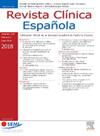Perfil de los pacientes con fibrilación auricular atendidos en servicios de medicina interna en España. Registro SUMAMOS-FA-SEMI
IF 1.7
4区 医学
Q2 MEDICINE, GENERAL & INTERNAL
引用次数: 0
Abstract
Aim
To update the profile of patients with atrial fibrillation (AF) who are treated in internal medicine wards according to characteristics implicit in elderly patients.
Material and methods
Multicenter national registry with one-year follow-up that includes adult patients diagnosed with AF. The sample is divided into three groups based on comorbidity and dependency (group 1, functional patients with little comorbidity; group 2, partially dependent patients with comorbidity; group 3, dependent patients with comorbidity) and their characteristics are described, differentiating between inpatients and outpatients.
Results
One thousand two hundred fifteen subjects were analyzed (mean age 81.5 ± 8.7, with 52.1% women). An increase in comorbidities associated with AF is observed compared to previous analyses in the same setting. There is a high rate of frailty (44.4%), and risk of malnutrition (52.9%) with significant differences between the established groups. An increase in baseline anticoagulant therapy was observed with fewer individuals treated in group 3, and a greater use of direct anticoagulants (62.3%) than anti-vitamin K drugs (22.2%), especially in group 3.
Discussion
The current profile of AF patients treated in internal medicine shows an aged but heterogeneous population with a higher rate of baseline anticoagulant therapy than in previous records with a greater use of direct anticoagulants, especially in the more comorbid and dependent population. We observed a high prevalence of frailty and malnutrition with differences between the established groups. This situation could have implications for establishing differentiated approaches.
在西班牙接受内科治疗的耳纤颤患者简介。SUMAMOS-FA-SEMI记录
目的根据老年房颤患者的特征更新内科病房房颤(AF)患者的资料。材料和方法多中心国家登记,为期一年的随访,包括诊断为房颤的成年患者。样本根据合并症和依赖性分为三组(1组,无合并症的功能患者;第2组,部分依赖并伴有合并症的患者;第3组,有合并症的依赖患者,描述其特征,区分住院患者和门诊患者。结果共纳入1215例患者,平均年龄81.5±8.7岁,女性占52.1%。与先前的分析相比,在相同的环境中观察到与房颤相关的合并症增加。虚弱率高(44.4%),营养不良风险高(52.9%),两组间差异显著。基线抗凝治疗增加,第3组治疗人数较少,直接抗凝药物的使用(62.3%)比抗维生素K药物(22.2%)更多,特别是在第3组。目前在内科治疗的房颤患者的概况显示,与以往的记录相比,老龄但异质性人群的基线抗凝治疗率更高,直接抗凝治疗的使用更多,特别是在更多合并症和依赖性人群中。我们观察到脆弱和营养不良的高流行率,在已建立的群体之间存在差异。这种情况可能对建立不同的办法产生影响。
本文章由计算机程序翻译,如有差异,请以英文原文为准。
求助全文
约1分钟内获得全文
求助全文
来源期刊

Revista clinica espanola
医学-医学:内科
CiteScore
4.40
自引率
6.90%
发文量
73
审稿时长
28 days
期刊介绍:
Revista Clínica Española published its first issue in 1940 and is the body of expression of the Spanish Society of Internal Medicine (SEMI).
The journal fully endorses the goals of updating knowledge and facilitating the acquisition of key developments in internal medicine applied to clinical practice. Revista Clínica Española is subject to a thorough double blind review of the received articles written in Spanish or English. Nine issues are published each year, including mostly originals, reviews and consensus documents.
 求助内容:
求助内容: 应助结果提醒方式:
应助结果提醒方式:


